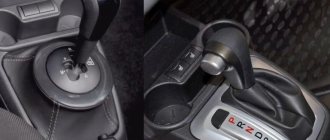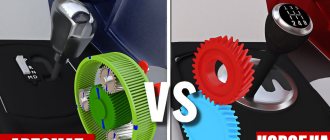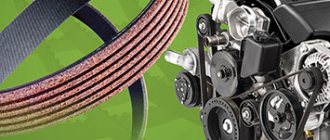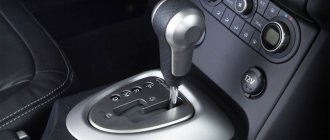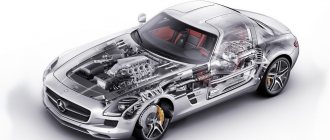What is better for a Lada car, AMT (robot) or automatic transmission (Jatco)?
In August 2012, sales of the Lada Grant with automatic transmission began; it was the first AVTOVAZ car to have an automatic transmission installed as standard on the assembly line. Almost three years later (in March 2015), sales of the Lada Grant with AMT (automated manual transmission) began. Let's talk about the differences between these two transmissions, which can also be installed on Lada Kalina, Priora, Vesta and XRAY. What are their pros and cons, and which car is better to choose?
AMT for LADA Granta. Design Features
Cars of the LADA Granta family (sedan, liftback) have already received a proven AMT, which is installed starting in September 2014.
It was developed by engineers of JSC AVTOVAZ together with specialists from the German concern ZF Friedrichshafen AG, which is the author and owner of many modern technologies and innovative solutions in the field of drive systems. The design of the basic manual gearbox 2181 (modernization of gearbox 2180) was taken as a basis, on which the following were installed:
- 1. Electromechanical actuators that control gear shifting and clutch operation;
- 2. Input shaft speed sensor;
- 3. Controller.
2180 gearbox and electronic control unit
In addition, the following were completely removed from the gearbox:
- 1. Clutch drive;
- 2. Internal switching mechanism;
- 3. Cable gear shift drive.
Inside the car, the clutch pedal was removed, and instead of a mechanical (cable) gear shift drive, an electronically controlled selector was installed.
In addition to original design solutions, modern software was developed specifically for AMT, with the help of which the vehicle’s transmission is controlled.
'); if("undefined"===typeof loaded_blocks_drive){loaded_blocks_drive=[]; function n(){var e=loaded_blocks_drive.shift(); var t=e.adp_id; var r=e.div; var i=document.createElement("script"); i.type=”text/javascript”; i.async=true; i.charset=”utf-8″; i.src=»https://www.drivenetwork.ru/data/»+t+».js?async=1&div=»+r+»&t=»+Math.random(); var s=document.getElementsByTagName("head")||document.getElementsByTagName("body"); s.appendChild(i); var o=setInterval(function(){if(document.getElementById(r).innerHTML&&loaded_blocks_drive.length){n(); clearInterval(o)}},50)} setTimeout(n)}loaded_blocks_drive.push({adp_id:e ,div:t})})(47602)
All these changes, together with the electronic motor control controller and the on-board power supply network, made it possible to fully automate the processes of controlling the clutch and gear shifting, as well as ensuring high AMT functionality.
Advantages and disadvantages of automatic transmission
The Lada Granta/Kalina 2 is equipped with a Jatco automatic transmission; this gearbox has been installed on Nissan for more than two decades and has proven itself well during this time. Reviews from owners of Lada Granta with automatic transmission indicate that the automatic transmission shifts gears smoothly, on time and accurately. There is no excessive thoughtfulness, and sudden accelerations and braking do not confuse her.
The disadvantages of the machine include high fuel consumption, especially in urban areas, as well as very expensive repairs.
Impressive result of good work
As a result, we can come to the conclusion that the VAZ team managed to create a good “robot”. What is especially impressive is that the project initially included unification, allowing the design to be quickly adapted to a number of models. The new AvtoVAZ product is in no way inferior to its analogues. From what is known, no unit with a “robot” has such elastic and smooth operation of the power unit.
Therefore, the “traditional” Jatco “automatic” has been replaced by a new product. This happened because VAZ’s “robot” is really quite good and is capable of satisfying the needs of the most demanding drivers. But the partnership with the Japanese continues, because it is necessary to give potential buyers maximum choice.
Today, cars equipped with automatic transmission and automatic transmission practically do not differ in price. But a price increase is coming for currently inexpensive Japanese-made automatic machines. After all, automatic transmissions are imported from Japan complete with a cooling system and require Japanese wheel drives. For AMT, everything was developed at AvtoVAZ. The only exceptions are actuators, control unit and selectors. The difference in price between a manual transmission and a “robot” is only 20,000 rubles. Jatco, even without taking into account drives and cooling, costs more than twice as much as a “robot”.
Advantages and disadvantages of AMT
“Robot” is installed on a wider range of Lada cars (Granta, Kalina, Priora, Vesta and XRAY) and has a number of operating features. According to AVTOVAZ, the robotic gearbox is distinguished by its simplicity, reliability and efficiency. In addition, the robot is easy to maintain, and its repair cost is practically no different from repairing a manual transmission. Fuel consumption corresponds to that of a manual transmission.
The disadvantages of this transmission are mentioned in reviews of owners of Lada Priora with AMT. An “automatic” changes gears with almost no loss of traction torque, but a “robot” cannot do this. It is this moment that car enthusiasts do not like. In addition, there are discussions about the hum and howl of the AMT.
How the AMT robot accelerates
Just press the gas pedal to the floor, and the car accelerates. We catch up with the flow and drive calmly. The box is a little thoughtful. If you press the gas sharply, then for some time it still maintains a mode similar to sports. That is, it shifts to a higher gear, but not immediately. Probably waiting to see if the driver will still press on the gas.
An additional device is built into the gearbox housing, which presses the clutch instead of a person. This mechanism is called an actuator. But its durability is debatable. After a short time of operation, the actuator begins to creak and make noise. To fix this problem, you have to disassemble it and lubricate it. And it costs a lot.
Overall, I like this box. I don't see anything bad in it yet. The operation is similar to a classic automatic, only the shifts are felt more strongly. But it’s quite bearable and tolerable; after all, it’s AvtoVAZ. I don’t know what about reliability, we’ll see, it’s not Japanese quality, of course.
What is the difference between AMT and automatic transmission
| Parameter | AMT or "robot" | Automatic transmission Jatco |
| Surcharge | 25,000 rubles | 50,000 rubles (imported parts) |
| Fuel consumption | less or like a manual transmission | more than a manual transmission by about 1l/100km |
| Clearance | like a manual transmission | because The automatic transmission dimensions are larger, the ground clearance is 2 cm less |
| Maintainability | like a manual transmission | not officially provided |
| Gear shift | only felt when shifting to a higher gear (during acceleration) | not noticeable either when accelerating or decelerating |
| Availability of manual mode | There is | No |
| Kickdown function | There is | There is |
| Adaptation to driving style | yes (more than 20 cards) | No |
Both transmissions make driving easier, which significantly reduces driver fatigue, especially in traffic jams.
What transmission do you recommend for Lada cars? Let us remember that cable “mechanics” are famous for their howling.
Source
Robot box on the Opel Astra
We have already discussed the general situation regarding Opel above; I would like to separately touch on the Astra car, which used a robotic gearbox. “Astra”, reviews of which are controversial, but not bad, received a first-generation design, so we can say that it is designed for an amateur. Moreover, we are talking about the process of operation, and not about repair. Some drivers note that it is better with such a gearbox than with a manual one. However, its work is much worse when compared with the conventional and most famous automated one. Many robot boxes don’t like traffic jams and sometimes start to malfunction. Depending on the nature of the failure, the unit can be much cheaper to repair than an automated transmission. However, it cannot be said that this is really true in all cases.
Automatic transmission "Lada Granta": appearance, principles of operation, testing and repair
The Lada Granta automatic transmission has 6 operating modes: forward, reverse, neutral, parking, and also forward with a limit of up to 2 gears. The control system consists of sensors that read all vehicle parameters, an ECU and performers - solenoids. Actuators change gears using servos.
The automatic transmission on the Lada Granta is represented by a VAZ-2182 robotic gearbox and a Jatco hydraulic automatic transmission. In the reviews, robot owners disagreed, discussing the advisability of purchasing Granta with AMT. The Lada Granta automatic transmission received a lot of positive feedback. Its main disadvantage is increased fuel consumption (unlike the Lada Granta with a manual transmission).
Lada Granta AMT: conclusions and performance characteristics
| We like | widespread work on bugs; new rear view mirrors; a domestic robot that is better than Opel’s and Toyota’s. True, mid-2000s. |
| We do not like | nostalgic communal crampedness |
| Data is given for Lada Granta AMTc with 1.6 engine and MT | |
| Engine | petrol |
| Number and arrangement of cylinders | 4 in a row |
| Working volume, cm³ | 1 596 |
| Max. power, hp | 102/5800 |
| Max. torque, Nm | 148/4000 |
| Drive unit | Front |
| Transmission | robotic, 5-speed |
| Front suspension | independent, with McPherson struts and anti-roll bar |
| Rear suspension | semi-independent, lever, spring |
| Front brakes | d claims |
| Rear brakes | drums |
| Maximum speed, km/h | 180 |
| Acceleration time sec. | 12,3 |
| Dimensions, mm | |
| length | 4 260 |
| width | 1 700 |
| height | 1 500 |
| wheelbase | 2 476 |
| ground clearance | 160 |
| Curb weight, kg | 1 075 |
| Tires | 175/65 R14 |
| Trunk volume, l | 520 |
| Fuel consumption, l/100 km | |
| urban cycle | 9 |
| suburban cycle | 5,2 |
| mixed cycle | 6,6 |
| Fuel tank volume, l | 50 |
We thank AMK-Ekaterinburg for the test car. Text: Kirill Zaitsev Photographer: Nikolay Kovalevsky Illustrations, graphics: Jatco, Renault, Lada, archive 66.RU
Roskomnadzor killed the Telegram bot 66.RU. Subscribe to the backup channel.
What boxes were installed on different car models
The automatic version of the Lada Granta was launched in 2012. The robotic gearbox was developed in 2014, the first “Grant” with manual transmission appeared in 2015.
Robot
The 5-speed AMT VAZ-2182 can be found on Grants with 16-valve engines under the hood. The robot was installed on Granta on different body types in different years:
- sedan - since 2015;
- hatchback, station wagon, liftback - from 2022;
- "Cross" - from 2022.
Machine
The Japanese automatic is installed on Lada Granta varieties with a 16-valve engine in the body:
- sedan - since 2012;
- liftback - since 2014;
- hatchback, station wagon, “FL” - from 2022.
AvtoVAZ engineers sought to find a cheap and reliable automatic transmission. The Japanese development of Jatco – JF414E – was chosen. It was not immediately possible to reconcile the 4-speed with the domestic engine. The help of Austrian colleagues was needed. Through the joint efforts of AvtoVAZ and AVL engineers, it was possible to integrate Jatco into the Lada system and speed up the operation of the gearbox.
Differences between AMT and other types of gearboxes
Unfortunately, there is no “preload” mode, which is available in conventional automatic transmissions, when the car starts to move from idle. There is no way to overcome small hills by releasing the gas pedal - a car with a robotic transmission must in such situations put on the handbrake or apply gas. During the development of the transmission, foreign analogues equipped with a recoil mode were studied. As a result, we decided not to include this feature in our robotic transmission, since the electronics only notice a steep climb, and a small hill for a momentarily distracted driver can cause a rollback and, in urban conditions, cause an accident. The same danger comes from releasing the brake on a car equipped with a classic automatic transmission with “drive” turned on.
At first, the robotic transmission requires the driver to get used to and control his actions. You need to be especially careful in urban environments that require frequent difficult operations: starting, making a U-turn, turning off the engine, parking. But all the required actions are intuitive and logical, so getting used to the new product happens very quickly. By the way, both CVTs and conventional automatic transmissions need to adapt to them. It is much more difficult for a beginner to get used to ordinary mechanics.
The undoubted advantage of the robotic version of the device is the complete elimination of errors and breakdowns caused by subjective factors. At the same time, it will not be possible to engage the wrong gear, for example, reverse while moving forward, in such a gearbox. In addition, the “robot” makes it possible to control the temperature in the gearbox. A special lamp signals critical overheating. This option is not available in either manual or automatic transmissions.
Users of automatic transmissions notice the moments when gears are changed in AMT. Indeed, in the Japanese automatic transmission Jatco, gear shifting occurs very smoothly without obvious power breaks, and the “robot” needs a short time to change speed. AMT is a relatively simple design: in a classic VAZ gearbox, shifting is controlled by two ZF actuators - German-made electrical actuators. One of them helps the driver to depress the clutch, and the second is responsible for engaging a specific gear.
When transferring AMT to Granta from Lada Priora, the settings of the control unit were changed and it was reconfigured. Now the controller unit is located in the area of the left headlight under the bumper. This is done to improve its protection and ensure operation in any weather.
If the speed of mode “A” seems insufficient, then in mode “M” (manual) the speed is quite decent. Gear shifting in this mode occurs as quickly as an experienced driver can do with a conventional manual transmission. It is no coincidence that AMT is called “two in one” - a full-fledged “automatic” plus the ability to switch in manual mode.
In general, the car is capable of both acceleration for overtaking slow vehicles and driver acceleration. On the other hand, they are able to move smoothly without disturbing passengers. If the car starts to skid, a special algorithm is activated: if the speed is less than 5 km/h, there is no need to press the brake.
But the main advantage of AMT is reduced fuel consumption. This indicator outweighs all the talk about how a “robot” is specific compared to an “automatic machine”.
Fuel costs with AMT:
- Test drive in the city - 8.1 l/100 km;
- operating mode on the highway - 5.1 l/100 km;
- operating mode in the city - 6.5 l/100 km;
- “automatic” Lada – more than 10 l/100 km.
The AMT project is the hard-fought and beloved brainchild of the AvtoVAZ team. Research to find an alternative to “mechanics” has been going on for a long time. Many of their samples were tested: CVTs, classic “automatic machines”, “robots”. The option of using foreign AMT was also analyzed.
The Russian product won - the president of AvtoVAZ gave the go-ahead for the introduction of the VAZ robotic gearbox with ZF actuators.
The success of the Lada Priora projects in 2014 and Lada Granta in 2015, equipped with AMT, gives hope for the successful implementation of a new transmission complete with 8-valve and 16-valve VAZ engines. This will make it possible to equip other later AvtoVAZ models with an automated manual transmission: Lada Vesta and the Lada XRAY SUV. New Lada models have a different architecture and require a transition to Euro-6 environmental standards. For this purpose, the new transmission option will be changed, but the technology's design features and service will remain the same.
Features of automatic transmission on Lada Granta
Automatic transmissions "Grants" differ in design and operating mechanism.
Robot design
- clutch engagement actuator (the unit includes a clutch fork rod, an electric motor, a drive gear, a wear compensator and a compensation spring);
- gear shift mechanism (consists of a rod, two electric motors, gear shift and gear selection drives);
- clutch fork;
- speed sensor;
- selector knob.
The model used with a single clutch disc is considered obsolete. Manufacturers of foreign cars have switched to preselective robots, the design of which includes 2 clutches.
Hydraulic automatic machine design
The 4-speed is based on the development of the Nissan REF403A. Japanese engineers modernized the model: they made the machine more powerful, reduced weight and production costs. The transverse hydraulic automatic is designed for installation on a front-wheel drive passenger car with an engine capacity of no more than 1.6 liters. The automatic transmission design has 4 units:
- torque converter - a unit that ensures the transmission of torque from the engine to the input shaft;
- control valve block - consists of various sensors, solenoid valves and an ECU module;
- planetary part - consists of two planetary gears, allowing for 4 speeds, among the components of the unit are 3 multi-disc clutches, a multi-disc brake, an overrunning clutch and a brake band;
- clutches and brake mechanisms - clutch elements responsible for selecting gears and switching between speeds;
- pump - supplies working fluid to the torque converter and other components.
Jatco engineers have provided protection against driver errors. The electronic unit prevents incorrect manual gear shifting. If the car is moving forward, then it will not be possible to engage reverse. A separate system analyzes the temperature of the unit and signals when there is unacceptable overheating.
Specifications
The AvtoVAZ robotic gearbox operates in 4 modes: automatic, reverse, neutral, manual control. When choosing the latter option, the driver changes gears independently, while the clutch is controlled by the computer. The robot can change from manual mode to automatic if the engine accelerates to high speeds that could damage the transmission.
Automatic transmission
The Lada Granta automatic transmission has 6 operating modes: forward, reverse, neutral, parking, and also forward with a limit of up to 2 gears. The control system consists of sensors that read all vehicle parameters, an ECU and performers - solenoids. Actuators change gears using servos.
The machine parameters have changed. The installation of an automatic transmission on the Lada Granta led to a change in ground clearance (up to 140 mm from the standard 160 mm). The weight of the car increased, which resulted in the adjustment of the shock absorber springs (changed to stiffer ones). The trunk volume remains the same – 480 liters.
Service details
The instructions for the VAZ-2182 contain a recommendation to change the oil every 75 thousand kilometers. From the factory, the box is filled with Rosneft Kinetic Service 75W85 GL-4 with a volume of 2.25 liters.
The Lada Granta automatic transmission is considered one of the most unpretentious automatic transmissions, but it also requires timely maintenance: checking the level of the filled transmission, changing the oil and oil filter (although, according to the manufacturer, the transmission fluid will be enough for the entire service life of the box). According to the recommendations of the official dealer, the oil needs to be updated every 60 thousand kilometers.
During the replacement process, the technician assesses the condition of the hydraulic machine. If there is a large amount of metal shavings on the magnets, it is worth carrying out a major overhaul of the unit. It may happen that a complete oil change will “kill” the machine, so it is better to disassemble the box and check the integrity of the internal components. The technician must remove the box, disassemble the assembly, replace clutches, seals and gaskets and other worn or damaged elements. The JF414E hydraulic unit fails in exceptional cases; its flushing is required extremely rarely.
From the factory, the automatic transmission is filled with Nissan ATF Matic-S or Genuine EJ-1 transmission fluid. When replacing, it is better to buy the same oil, although JF414E is tolerant of other compounds. The total oil volume is 5.4 liters; a partial replacement will require 3 liters of fluid. Together with the transmission, the coarse filter and the pan gasket of the Grants gearbox are changed.
If the car's computer begins to signal errors, you need to carry out diagnostics. To do this, the Lada Granta is driven to a showroom or car service center. You can take readings yourself. To do this you will need an on-board computer – multitronics. Some “Grants” configurations are equipped with it from the factory. Not everyone likes the standard device installed in the console, as it has limited functionality. Car owners buy and install multitronics with a color display and a wide range of options.
Fuel consumption by automatic transmission on Grant
The efficiency of the car depends not only on the engine power, but also on the type of transmission box. Consumption of 95 gasoline for cars with different types of transmissions and installed engines is presented in Table 1.
Gearbox comparison
Table 1. Fuel consumption of Lada Granta
| Gearbox type | Engine volume and power | Combined cycle fuel consumption per 100 km, l |
| Manual transmission | 1.6 l, 106 hp | 6,5 |
| 1.6 l, 87 hp | 6,8 | |
| Manual transmission | 1.6 l, 106 hp | 6,5 |
| Automatic transmission | 1.6 l, 98 hp | 7,2 |
The data given in the table are factory data, i.e. obtained as a result of a test, and not in real conditions. Actual consumption depends on the weight of the loaded vehicle, road conditions, driving style and usually deviates upward. According to owners' reviews, in winter, when the car is warmed up and when driving mainly in the city, up to 16 liters of fuel can be consumed per 100 km.
Design of a robotic gearbox AMT or VAZ 2182
The idea of creating their own automatic machine was nurtured by AvtoVAZ designers for many years, but they lacked the qualifications. Therefore, we decided to turn to foreign specialists again.
At first, negotiations took quite a long time with the famous Italian company Magneti Marelli, but the offer received later from the German concern ZF turned out to be much more profitable. As a result, AvtoVAZ management decided to equip the currently most modern domestic mechanics, the VAZ 2180, with electromechanical actuators from a German company.
A
— clutch actuator; B
— gear shift actuator;
B
— clutch fork;
G
— speed sensor on the input shaft;
D
— control knob in the cabin.
1
— gear selector rod;2
— gear shift drive;
3
— gear selection drive;
4
- electric motors.
1
— drive gear;2
— clutch fork rod;
3
— wear compensator;
4
- compensation spring;
5
- electric motors.
The result was a typical robot with an electric drive of a single clutch disc. Such models were popular among European or Japanese manufacturers ten years ago. At the moment, almost all the leading automobile concerns in the world have long abandoned them in favor of an even more modern transmission: preselective robots with two clutches.
This issue of Good Mechanics is entirely dedicated to the very first domestic manual transmission.
Pros and cons of “Grants” with automatic transmission
Both boxes have their advantages and disadvantages. The automatic is more reliable, but more gluttonous. The robot consumes less fuel, but driving the VAZ-2182 is uncomfortable.
Pros and cons of the robot
The outdated single-clutch design has many disadvantages:
- Lack of comfort. Gear shifting is not smooth enough. Owners of Granta with a robot complain about jolts during acceleration.
- Slow operation of the box. Speed changes occur with a delay.
- Unreliable, the service life with careful driving hardly reaches 200 thousand km.
- Afraid of slipping.
- When the movement begins, a rollback occurs.
- No rolling mode. The automatic movement implemented in the automatic transmission was loved by the townspeople. Standing in a traffic jam, the driver just needs to release the brake pedal, and the car begins to roll forward. The robot will not move until the gas is pressed.
The VAZ-2182 has fewer advantages than disadvantages. The electrically controlled robot itself is inexpensive, and the main positive feature is low fuel consumption. Servicing a manual transmission is almost the same as for mechanics. Repairing a robot is cheaper than rebuilding an automatic transmission.
Pros and cons of a hydraulic automatic machine
A positive feature of the JF414E is its reliability and simplicity of design. The automatic feels equally good on the highway and on a dirt road. Another advantage is the relatively small size and weight of the unit. The hydraulic automatic machine is easy to maintain without requiring large expenses. At an official Lada dealer, the automatic transmission cannot be repaired; in case of failure, the entire unit is replaced. A new JF414E box costs about 100 thousand rubles; on Avito and car dismantling sites you can buy a restored unit for 2 times cheaper.
There are few negative reviews about the operation of the hydraulic automatic machine. Some owners complain that the Lada Granta automatic transmission lacks fifth gear. They note higher fuel consumption than the Lada Granta with manual transmission.
Due to its age, a time-tested design also has a negative side - many modern engineering solutions do not fit into an outdated unit. The 4th mortar is thoughtful and leisurely in its work. The weakest component of the JF414E is the ECU board. The part does not tolerate power surges and is very demanding on the quality and temperature of the oil. Lada Granta with hydraulic automatic transmission cannot be skidded.
Features of the future “behavior” of the robot
At the beginning of 2022, VAZ conducted surveys of users of cars with an AMT robot, probably noticing that many complaints were coming from car owners living in megacities, who are under the threat of regularly getting stuck in traffic jams, where the gearbox shows not entirely favorable “behavior.” And all this is due to the lack of the so-called “creeping mode”.
If we consider the conditions of being stuck in traffic jams, there are only two types of traffic jams:
- The first type is a standing traffic jam, where traffic occurs in the mode: drive 5-10 meters and stop. In this mode, judging by the reviews, the gearbox robot behaves quite well: the driver pressed the gas pedal - it moved smoothly and began to move, released the gas pedal - it stopped.
- The second type of traffic jam is when the flow of traffic moves at walking speed, where the notorious “creeping mode” is required. In this case, it is difficult for the driver to select the engine speed not in the first gear of the gearbox in order to move synchronously with the flow of cars in a traffic jam, since when adding gas, the gearbox takes a pause while the car is still rolling, and then begins sharp acceleration, while the driver releases the gas pedal and clutch turns off, etc. If you look from the side, the car moves jerkily.
According to yet unconfirmed information, it is precisely this problem of the AMT’s lack of a “creeping mode” that the VAZ developers plan to solve.
